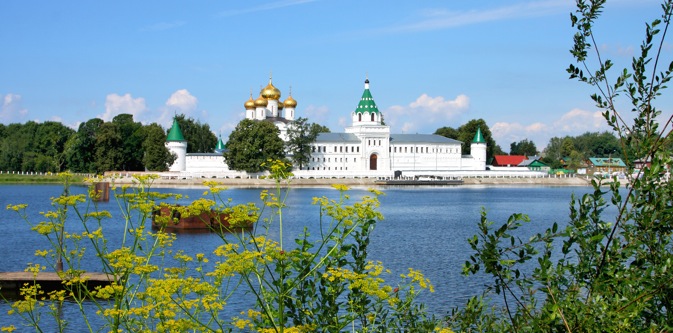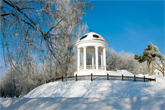A weekend in Kostroma

Kostroma is located at the confluence of the Volga and Kostroma Rivers. Source: Lori / Legion Media
Kostroma is a big river port, a light-industry centre and a serene spot on the banks of the Volga. Life is calm and quite uneventful outside production facilities, although there is always time for street festivals, new people to meet and a special ambiance to enjoy. Kostroma, with its residents who seem detached and withdrawn, may surprise you at first, but the town grows on you.
Starting point:
There are three ways to reach Kostroma: train (eight hours, around 2100 rupees one-way from Moscow), bus along Yaroslavskoe Highway (five hours, around 1120 rupees one-way from Moscow) or plane from either Moscow or St Petersburg to Sokerkino airport (about 40 minutes, about 3,500 rupees one-way from Moscow). Like any other Russian town, Kostroma looks its best in summer and if you are keen to have a tour, you should stay overnight.
Saturday, 9:00
First impressions:
If you go by bus, you will surely drive across the Kostroma bridge, which is almost 1,500 metres long. The Volga riverside is a favourite place for Kostroma residents to go for a walk: in the summer it offers a cool breeze and sites for barbeques, whereas in the winter it provides a breathtaking panorama of birch trees covered in ice and snow and Russian log houses.
Behind the medley of wooden houses stand standard Khrushchev-era apartment blocks, bearing-wall houses built in the 1970s, modern petrol filling stations and towers. Wooden houses with old boilers remain in some back yards: outdated gas tanks heat a cast iron boiler that delivers heat to all the radiators in the house.
10:00, Breakfast:
Roga i kopyta is a café with a most attractive interior in the historic town centre (2a, Sovietskaya Street). The designers made use of the items and characters from the classic Soviet satirical novel The Twelve Chairs by Ilf and Petrov. European desserts and pastries (cheesecake and tiramisu) become pie and crème brûlée, plus local pancakes with a variety of fillings (105-140 rupees per dish), which are considered to be the best in town.
The cafés and cars are never crowded, so you can always relax. In Roga i kopyta, you can also listen to soundtracks from your favourite Russian films.
11:00-15:00, Local sites:
Sovietskaya Street is Kostroma’s main street. It features shops of local manufacturers, cafés, restaurants, shopping centres and theatres. The main square on Sovietskaya Street is named after the Russian national hero Ivan Susanin but the locals call it the ‘frying pan’ (Skovorodka). It is believed that, in the 19th century, horse-drawn carriages went around the square so many times that a perfect smooth circle was formed, looking exactly like a giant frying pan.
Streets radiate from Skovorodka in various directions in a fan shape: a wealthy merchant used to live on each street a few centuries ago and there were no other competing merchants on each street. They all took their merchandise to the shopping arcade, which still exists. The old shopping stalls, dating from the late 18th-early 19th century, occupy a few blocks in central Kostroma.
The shopping arcade gallery (which is what they normally call the stalls), with their smooth floors made of stone flags, bright signboards and shop windows, were not only the centre of busy commercial life but also a place for Kostroma residents to meet. The stalls are now occupied by small shops and cafés. They were originally built in two levels, for the warehouse and the shop. After a renovation, little was left of the original buildings in the shopping arcade but this is still where you will find the best shops in town.
15:00-17:00, Souvenirs:
The people of Kostroma work in linen, woodworking and jewellery factories just as their forefathers did. The most popular places to buy or admire local handicrafts are the Linen and Birchbark Museum (38, Tereshkova Street) and the Show Room of Kostroma Jewellery Factory (27, 2nd Volzhskaya Street). Here you can buy jewellery, linen table cloths, wooden whistles and other typical Kostroma souvenirs.
17:00-18:00, A pancake-break
Compared to Moscow and St Petersburg, chefs seem to take forever to cook your meals and Kostroma natives will appear terribly slow or maybe even lazy. People stroll in the streets and back yards, often stop for long conversations and take their time looking around them: bustle is definitely the wrong word for Kostroma.
Yet, like in all Russian towns, local young people never sleep at night but populate the Kostroma dance floors.
If you walk around the town until late at night, you can have a bite at the 24/7 Lakomka pancake house (61a, Sovietskaya Street), which has survived all of Russia’s economic upheavals owing to support from the local factory. A pancake and egg with tea and honey is just 50 rupees, and for 140 rupees you can have a sumptuous dinner.
18:00+
Khrushchevka, one of the most popular bars in town, is close to the town centre (Sovietskaya Street, 1 Krasnye Ryady). Try the traditional Russian cuisine at local prices (salads and second courses are all within 300 rupees), watch Russian cartoons, play draughts, backgammon, chess, solve a Rubik’s Cube. You can also dance on any flat surface you like in the bar on weekend nights.
The interior is designed in Soviet style, with retro furniture and accessories, either very well preserved or restored, which makes the bar look like a luxury Soviet apartment back in Nikita Khrushchev’s time.
Darling, Don’t Wait Up is another youth bar (2/15, Nizhnyaya Debrya Street). Business lunch is from around 280 rupees and hardly any of the dishes on the menu cost more than 350 rupees. The name of the bar gives you an idea of what is going on inside: local DJs play until 4 a.m. and guests never want to leave.
21:00-6:00, Kostroma modern
Most of the shopping centres and stores close at 18:30 even in the centre of Kostroma, with just a few open until 22:00. To have fun, you should take a taxi (140 rupees will take you anywhere) to the linen factory district to see one of the Stantsiya art venue shows (3a, Yerokhova Street). Stantsiya cooperates with many organisations and arranges regular theme parties and performances, shows foreign films with Russian subtitles and hosts discos in headphones.
Sunday, 12:00
Ice room:
Kostroma is the native town of Snegurochka (the Snow Maiden), who is the granddaughter of the Russian Santa Claus, called Father Frost. A large log-house was built at 38, Lagernaya Street with an ice room, where the temperature never rises above minus 14. Snegurochka’s assistants are house elves and Cat Bayun, who take care of the house when Snegurochka is away, act as guides for tourists and tell fairy tales.
14:00-16:00, Monasteries and refectories
You should also visit the town’s two big monasteries: Holy Trinity Ipatievsky Monastery and Bogoyavlensko Anastasiin Cathedral. The two churches have icons that have been recognised as miracle-working ones by the Russian Orthodox Church. You can have dinner in a refectory for less than 280 rupees.
16:00
30-minutes’ drive from Kostroma is an elk farm in the village of Sumarokovo, where they have been breeding young stock, keeping adult elks and studying the biology of the species since 1985. You can take a tour of the farm, feed the elks and drink elk milk for a fee of around 490 rupees.
Kostroma is so small that you can walk across the town in half an hour. Whatever route and sites you choose, you should remember two things: obtain information about local events, for there is always an open seminar or a concert in Kostroma. And do not believe vendors with carts: a fresh cake is one that has just been baked, not delivered.
All rights reserved by Rossiyskaya Gazeta.
Subscribe
to our newsletter!
Get the week's best stories straight to your inbox
.jpg)

